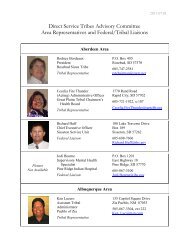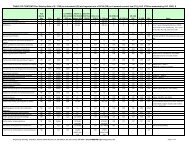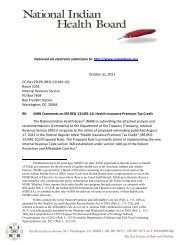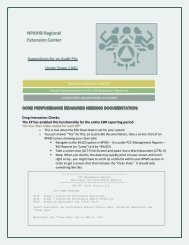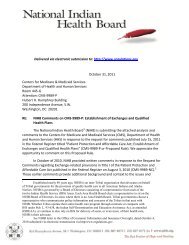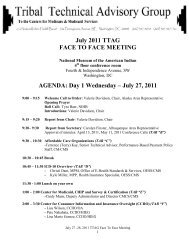mmpc - National Indian Health Board
mmpc - National Indian Health Board
mmpc - National Indian Health Board
Create successful ePaper yourself
Turn your PDF publications into a flip-book with our unique Google optimized e-Paper software.
Draft Report: Currently being circulated for Tribal leader and health director review and<br />
comment. Please provide comments by October 30, 2012 to Liz Heintzman at the<br />
<strong>National</strong> <strong>Indian</strong> <strong>Health</strong> <strong>Board</strong> at EHeintzman@nihb.org.<br />
While the Supreme Court’s civil rights jurisprudence has generally applied strict scrutiny when<br />
reviewing classifications based on race, color, or national origin, 14 in Mancari the Court determined<br />
that this test was not appropriate when reviewing an <strong>Indian</strong> employment preference law. Indeed, the<br />
Court declared that the practice under review was not even a “racial” preference. Rather, in view of<br />
the unique historic and political relationship between the United States and <strong>Indian</strong> Tribes, the Court<br />
characterized the preference law as political rather than racial, and said that “[a]s long as the special<br />
treatment [for <strong>Indian</strong>s] can be tied rationally to the fulfillment of Congress’ unique obligation toward<br />
the <strong>Indian</strong>s, such legislative judgments will not be disturbed.” Id. At 555. The Court found that hiring<br />
preferences in the federal government’s <strong>Indian</strong> service were intended “to further the Government’s<br />
trust obligation toward the <strong>Indian</strong> tribes,” to provide greater participation in their own selfgovernment,<br />
and “to reduce the negative effect of having non-<strong>Indian</strong>s administer matters that affect<br />
<strong>Indian</strong> tribal life” in agencies, such as the BIA, which administer federal programs for <strong>Indian</strong>s. Id. At<br />
541-542 (emphasis added). 15<br />
Once the link between special treatment for <strong>Indian</strong>s as a political class and the federal government’s<br />
unique obligation to <strong>Indian</strong>s is established, “ordinary rational basis scrutiny applies to <strong>Indian</strong><br />
classifications just as it does to other non-suspect classifications under equal protection analysis.”<br />
Narragansett <strong>Indian</strong> Tribe v. <strong>National</strong> <strong>Indian</strong> Gaming Comm’n., 158 F.3d 1335, 1340 (D.C. Cir. 1998).<br />
The <strong>Indian</strong> hiring preference sanctioned by the Court in Mancari is only one of the many activities the<br />
Court has held are rationally related to the United States’ unique obligation toward <strong>Indian</strong>s. The Court<br />
14 The Supreme Court has interpreted Title VI to allow racial and ethnic classifications only if those classifications are<br />
permissible under the Equal Protection Clause. Regents of Univ. of Cal. v. Bakke, 438 U.S. 265, 287 (1978). In this regard,<br />
the Court has also stated that "all racial classifications, imposed by whatever federal, state, or local governmental actor,<br />
must be analyzed by a reviewing court under strict scrutiny. In other words, such classifications are constitutional only if<br />
they are narrowly tailored measures that further compelling governmental Interests." Adarand Constructors, Inc. v. Pena,<br />
515 U.S. 200, 227 (1995).<br />
15<br />
<strong>Indian</strong> Preference provisions are not limited to the BIA, and have been applied in a variety of federal programs for the<br />
benefit of <strong>Indian</strong>s. Section 7 of the <strong>Indian</strong> Self Determination Act, for example, establishes a broad federal policy of<br />
providing hiring, training, and contracting preferences for <strong>Indian</strong>s in contracts or grants with <strong>Indian</strong> organizations across all<br />
federal agencies. 25 U.S.C. § 450e(b). <strong>Indian</strong> preference provisions are also found in other statutes. See, e.g., 42 U.S.C. §<br />
9839(h) (establishing an <strong>Indian</strong> hiring preference at American <strong>Indian</strong> Programs Branch of Head Start Bureau); 20 U.S.C. §<br />
3423c(c) (establishing an <strong>Indian</strong> employment preference in the Office of <strong>Indian</strong> Education in the Department of Education).<br />
See also Preston v. Heckler, 734 F.2d 1359 (9th Cir. 1984) (<strong>Indian</strong> Preference Act requires Secretary of HHS to adopt<br />
standards for evaluating qualifications of <strong>Indian</strong>s for employment in the <strong>Indian</strong> <strong>Health</strong> Service that are separate and<br />
independent from general civil service standards).<br />
44




